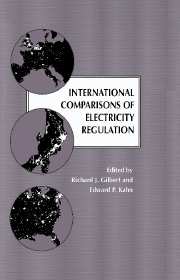Book contents
- Frontmatter
- Contents
- Preface
- International Comparisons of Electricity Regulation
- 1 Introduction: International comparisons of electricity regulation
- 2 Regulation, public ownership and privatisation of the English electricity industry
- 3 How should it be done? Electricity regulation in Argentina, Brazil, Uruguay, and Chile
- 4 From club-regulation to market competition in the Scandinavian electricity supply industry
- 5 Competition and institutional change in U.S. electric power regulation
- 6 The Japanese electric utility industry
- 7 Regulation of the market for electricity in the Federal Republic of Germany
- 8 The evolution of New Zealand's electricity supply structure
- 9 Regulation of electric power in Canada
- 10 The French electricity industry
- 11 The Yugoslav electric power industry
- Index
8 - The evolution of New Zealand's electricity supply structure
Published online by Cambridge University Press: 21 March 2010
- Frontmatter
- Contents
- Preface
- International Comparisons of Electricity Regulation
- 1 Introduction: International comparisons of electricity regulation
- 2 Regulation, public ownership and privatisation of the English electricity industry
- 3 How should it be done? Electricity regulation in Argentina, Brazil, Uruguay, and Chile
- 4 From club-regulation to market competition in the Scandinavian electricity supply industry
- 5 Competition and institutional change in U.S. electric power regulation
- 6 The Japanese electric utility industry
- 7 Regulation of the market for electricity in the Federal Republic of Germany
- 8 The evolution of New Zealand's electricity supply structure
- 9 Regulation of electric power in Canada
- 10 The French electricity industry
- 11 The Yugoslav electric power industry
- Index
Summary
Introduction and summary
Given the original technological and economic dominance of large-scale hydro projects in New Zealand, the strong link of electricity with national and regional development in a sparsely settled country, and the leading role of government in economic development in general, initial direct public control of generation and transmission was a logical choice. Under this system, most of New Zealand's good hydro projects have now been developed.
By the 1970s discovery of coal, gas and geothermal resources, difficulties in achieving scale economies in a small country, and a concern with energy security resulted in a perceived coordination problem among various public authorities involved in supply and pricing. To improve energy supply performance within the public sector, electricity supply was placed under the control of the Ministry of Energy, which adopted a centrally coordinated energy planning structure. This reorganisation was consistent with the widespread intervention in the economy by the government of the time.
A subsequent general economic crisis resulted in election of a government that embraced a radical reorientation in policy toward privatisation. As just one element of this revolution in policy, wholesale supply was removed from political control and set up as an independent public corporation (the Electricity Corporation of New Zealand, or ECNZ) with commercial objectives. This move was conceived as the first step in a plan for privatisation of generation and deregulation of distribution that parallels the privatisation policies implemented in many other sectors of what had been an economy with unusually extensive government production.
- Type
- Chapter
- Information
- International Comparisons of Electricity Regulation , pp. 312 - 365Publisher: Cambridge University PressPrint publication year: 1996
- 4
- Cited by



